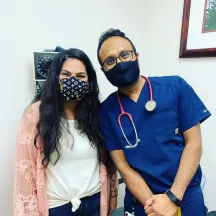Flexible sigmoidoscopy
A flex sigmoidoscopy examines your rectum and lower part of the colon with a lighted tube called a sigmoidoscope. This is a method of screening for colorectal cancer.

What is a flex sigmoidoscopy?
This colorectal cancer screening method examines only the rectum and lower part of the colon with a lighted tube called a sigmoidoscope.
This option:
- Can find cancer in earliest stage, when most treatable
- Rarely has complications
- Is usually less expensive option to colonoscopy (when not a routine screening)
The details
- Flexible sigmoidoscopy, or flex sig, is a procedure used to see inside the sigmoid colon (the last one-third of the colon) and rectum (which connects the sigmoid colon to the anus).
- Using a flexible tube (scope), your doctor can detect inflamed tissue, abnormal growths and ulcers.
- This screening method is used to look for early signs of cancer and can help doctors diagnose unexplained changes in bowel habits, abdominal pain, bleeding from the anus and weight loss.
Will my insurance cover it?
Many insurance plans cover the screening test every four to five years starting at age 50. Medicare covers it once every four years; you pay 20% of the Medicare-approved amount after Part B deductible.

The pros & cons
Advantages
- Can identify polyps before they turn into cancer
- Usually does not require sedation
- Moderate cost; covered by most insurance
- Can accurately find polyps in the lower part of the colon
Disadvantages
- Not all polyps can be removed during the procedure but they can be biopsied; will need to get a colonoscopy if biopsy is positive for colorectal cancer
- Requires enema preparation
- Patients may find test uncomfortable or embarrassing
- Small risk of perforation or bleeding
- Does not examine the first half of the colon

The prep
Preparation for flex sig can vary. Some doctors will recommend one or more enemas before the procedure, others will recommend a clear liquid diet for one to three days, while others will advise you to forgo any prep.
Your doctor will tell you the specifics on what will be the best prep method for you.
The procedure: what to expect
- To start the procedure, you will lie on your left side on an exam table.
- Your doctor then inserts a long, flexible, lighted tube called a sigmoidoscope, or scope, into the anus and slowly guides it through the rectum and into the sigmoid colon.
- The scope inflates the colon with air to give the doctor a better view.
- A tiny camera mounted on the scope transmits a video image from inside the colon to a computer screen, allowing the doctor to carefully examine the tissues lining the sigmoid colon and rectum.
- You may be asked to move periodically so the scope can be adjusted for better viewing.
- The lining of your colon is then examined again as the scope makes its way out.
- You may experience a feeling of pressure, bloating or cramping during the procedure, but this will quickly subside once the air passes out of you.
- And the best part: as soon as the procedure is finished, you can get dressed, leave on your own, drive and resume your normal diet and activities right after.
Getting others to get screened
Ten ways to encourage loved ones to get screenedTop resources

"Clinical trials gave us time": A daughter’s tribute to her mother’s courage
When Kate Shin’s mother faced rectal cancer, clinical trials gave them precious time together. Now, Kate shares her story to encourage access to screening and innovative care, including clinical trials.

Katie Couric Joins the Colorectal Cancer Alliance To ‘LEAD FROM BEHIND’
Katie Couric joins the Colorectal Cancer Alliance and Ryan Reynolds’ Maximum Effort to expand LEAD FROM BEHIND, a star-powered campaign breaking stigma and urging lifesaving colon cancer screening. Colon cancer is the preventable cancer.

20+ Colorectal Cancer Alliance Screen Smart Partners Encourage Secretary Kennedy to Uphold USPSTF Goal to Improve Health
The Colorectal Cancer Alliance and more than 20 Screen Smart partners urge HHS Secretary Robert F. Kennedy Jr. to protect USPSTF’s evidence-based process and no-cost preventive screenings like colorectal cancer screening, which save lives and improve national health.





